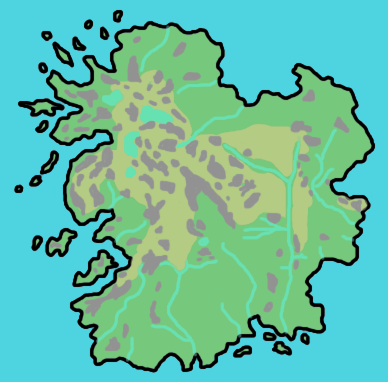Eitador Timeline
Eitador is a fictional continent, and the setting for the CYOAs:
NO FUTURE (Cyberpunk),
DAYBREAK (Mech Warfare), and
My Lady, My Leige (Medieval Town Builder)..
This isn't required reading, and you don't have to take the events here as being true for your particular story.
Your actions in your CYOA playthroughs could cause this timeline to not be true at all.
It only exists to offer you some extra worldbuilding, and to bridge the gaps between the different stories in canon.
It's likely to get plenty of small extensions in the future.
Separate pages are provided for the different time periods of Eitador's development, with links below.
Click here to return to the CYOA index.
- Ancient History (Pre 480)
- Post-Classical/ Medieval Period (480-1500) <- MY LADY, MY LIEGE
- Early Modern/ Renaissance Period (1501-1779)
- Middle Modern/ Industrial Period (1780-1946)
- Late Modern Period (1946-2099) <- DAYBREAK
- Postmodern Period (2100-2200) <- NO FUTURE
Geography
Eitador is a large continent located a short distance west of Portugal and North Africa,
between the Azores archipelago and the Canary Islands.
The coast of this continent is most green and fertile, with an especially verdant south east.
Head inland, however, and you will discover large areas of hostile desert.
Mountains are more frequent the further west you travel, and the entire western coast
is lined with beautiful and jagged cliffs. Aside from the Canaries and the Azores,
there are a number of islands surrounding the continent. The majority of the larger islands
are on the west side, where they are additionally noted as having sharp and unusual shapes.
The continent is warm for most of the year, generally speaking.
The Location of The Eitadorian Continent

Geographical Map of The Eitadorian Continent

Overview
The first major wave of migrants to Eitador was sometime following the desertification of the Sahara.
It experienced a population boom and a cultural boom when it began trading tin, discovered in the south east, with the Phoenician civilization.
Many small kingdoms appeared all over the continent. In the south, the Kingdom of Estrella, inspiration was taken from the continent's Roman neighbors.
In the west, Eitador's original culture was best preserved, and this lead to the emergence of a native Eitadorian religion known as 'Ascendency' in 673AD.
Further north, a raider culture developed, which lead to around 2/3rds of the continent being divided up amongst warlords around 800AD.
The continent's most famous historical period begins with Estrellan king, Valen the First. After overthrowing the tyrannical and unstable
king who came before him, Valen proved to be a very effective military general. He began a campaign of conquest that his grandson, Valen III,
would finish in 1587, uniting the entire continent for the first and only time in history.
One of Estrella's successor states, Brightfire, attempted to conquer the continent in 1675, and again in 1785, but they failed both times,
entering horrible stalemates with the northern nation of Puratova. The introduction of firearms and machinery to Eitador only made wars bloodier and more drawn out.
Brightfire tended to side with Spain in international matters, and Puratova tended to side with Britain.
They finally came together during the Napoleonic Wars to fight France, who they both recognized as a potential threat to the continent as a whole.
They also found a common enemy in the many anarchist and socialist uprisings of the late 1800s. The uprisings eventually lead to independence
for a number of minor nations, including Daybreak and Avosnia.
These minor nations did not fare well in the 20th century. Daybreak entered a long civil war that all of its neighbors used as a chance to make money.
Avosnia suffered under a series of authoritarian leaders. Despire this, the Avosnian city of Vitaria began to thrive.
When civil unrest swept the country, and the military failed to help, businesses in Vitaria took matters into their own hands.
They used battle mechs, being developed for the Daybreak civil war, to force Avosnia to recognize Vitaria as an independent city state.
Liberal democracies went into decline around the world in 2040, when the climate refugee crisis caused a wave of reactionary sentiment.
The rich continued getting richer, however, and Vitaria prospered most of all. By the time that the United States collapsed,
Vitaria had solidified its position as a global center of power. The rise of automation forced the implementation of UBI in most nations.
The rise of cybernetic and biological augments began to transform those with money into a new race entirely.
And Vitaria launched an airship that allowed its elite to escape the squalor of the streets.